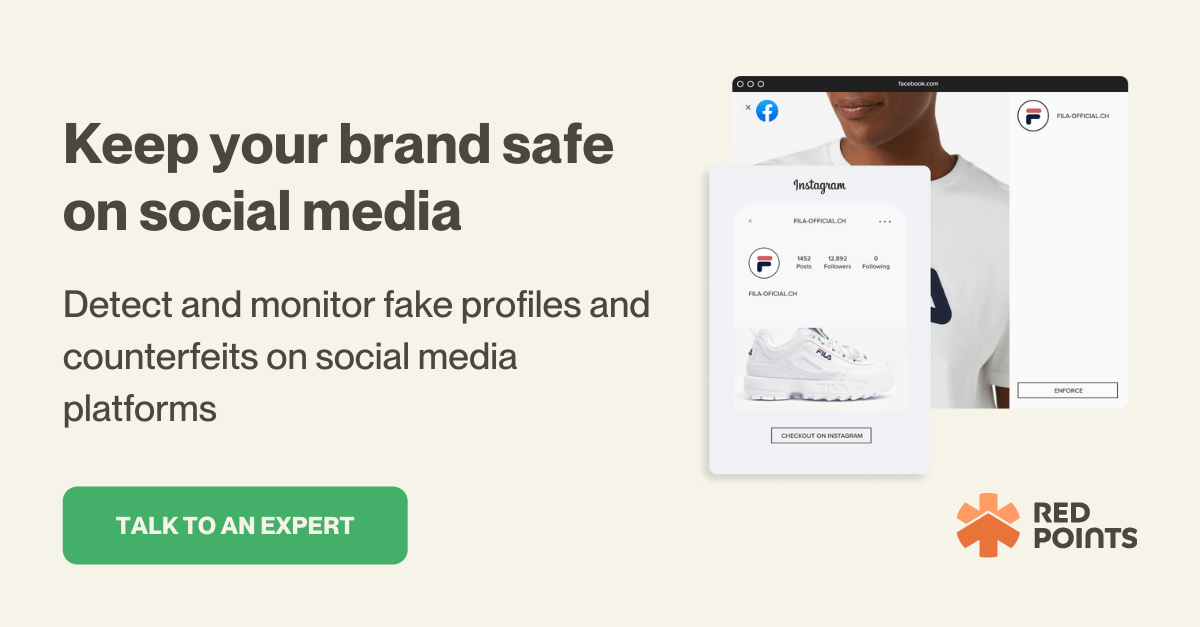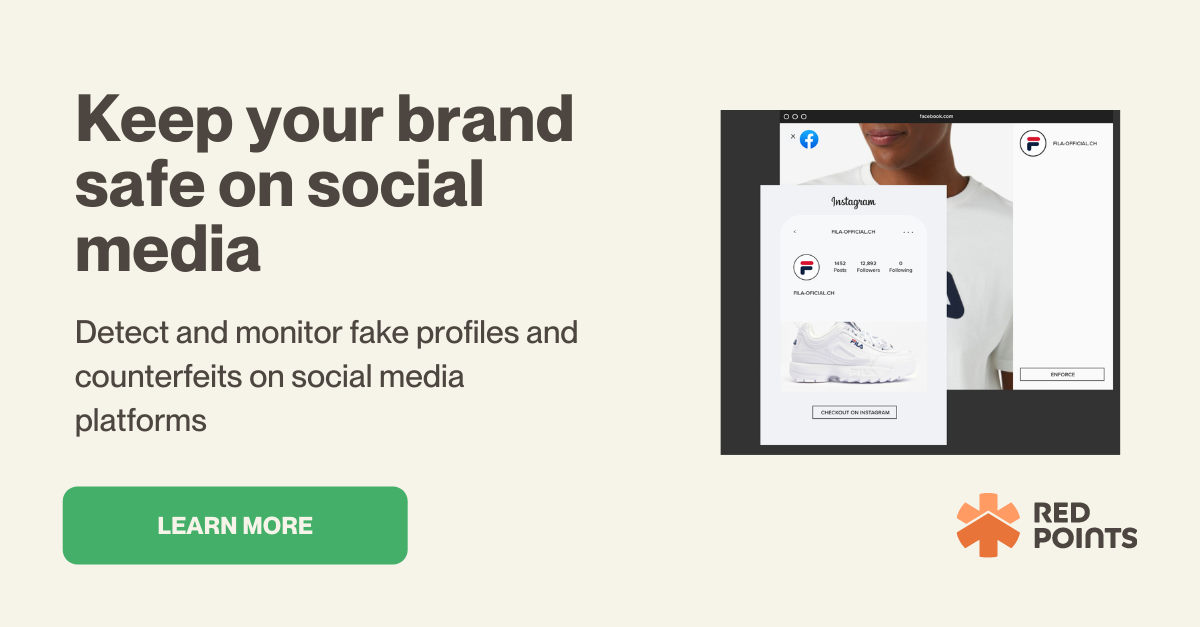Counterfeiters’ presence on social media is difficult to deny, and their presence seems to be growing. That said, there is light at the end of the tunnel.
- Registering IP is the first step to protecting a brand on social media.
- Protecting a brand on social media can be adopted by even small startups.
- Counterfeiting is an ongoing war, brand owners need to stay determined and positive.
Why You Need to Protect Your Brand on Social Media
The social media scenario has completely shifted ever since the COVID19 pandemic. Known as social commerce, consumers are actually shopping on social media platforms now rather than only roaming around.
In 2021, social commerce amounted to a total of $492 billion but is expected to grow to $1.2 trillion by 2025. At the moment, Facebook, Pinterest, Google, Snap, and TikTok all have ongoing partnerships with Shopify, which makes it very easy for Shopify merchants to promote their listings on any of these platforms.
IP leaders should keep a close eye on social media especially if they have a strong presence on the platforms. The first and foremost reason is that there is no other place where your customer base is more exposed. Anyone can go and pull out your followers on your official accounts and send illegitimate listings to them directly. Secondly, it’s easier for people to get confused, any fraudster can register a fake account and claim that they are employees of a brand and promote listings for fake products. Finally, it is the complexity of monitoring. On social media, there are channels, groups, profiles, ads, comments, and influencers, and only so many places that you need to take care of, which makes brands more vulnerable on social media than in other places.

Steps to Protect Your Brand on Social Media
Register your intellectual property
This is always the first step brands should take to protect their intellectual property on social media – by actually registering it. If this step is skipped, then brand protection becomes an unwinnable war. Having a strong IP portfolio will make the process of removing infringing posts and accounts much simpler.
As well as registering trademarks, design rights, etc domestically, it’s important to ensure additional registration for intellectual property in China too. Over 70% of the world’s physical counterfeit goods come from China, and western companies experience a great deal of trouble attempting to enforce their rights when they’re not also registered in the east. This is an important step even for companies with no intention of selling in China or outsourcing their manufacturing there since counterfeiters are able to copy product designs simply from seeing photos.
Controlling your pages on social media
The second pre-emptive advice for keeping your brand protected on social media is to maintain well-kept, updated social media profiles of your own. It’s important that you, as the official brand, have a page on all major social media platforms to prevent counterfeiters from impersonating your brand.
If you have a presence on a given platform, then not only will there be a clear comparison between the counterfeiters and the authentic brand, but your page will naturally rise to the top of any searches.
One way to make clear your social media account is authentic is to get a “verified” label on your account. Recognized as the blue tick against your Twitter handle or Instagram name, verification can be achieved through a simple application process, there are no stated minimum follower requirements.
Ensure your page links to all other official pages. This would include links to and from your website/s, between social media platforms, and between all profiles on the same platform if they are separated for language or geographical differences.
Make it easy to shop with your brand – if you have brick-and-mortar stores that sell your products officially, then consider including a map with legitimate stores near any visitors to your page. You want to make it as easy as possible for customers to access your real product – any bump in the road might push customers towards pages selling counterfeits.
On-platform reporting tools
All major social media platforms have reporting tools for counterfeits and bad-faith accounts. It’s important to utilize them as they’re the best tools that you have at your disposal to protect your brand on social media.
You want to start building trust between your brand and the platform. Keep the reports you submit as close to 100% accurate as possible – the platform will begin to streamline your reporting process once you’re seen as a credible source of reports, meaning more consistent and speedy compliance with your takedown requests.
Check the list below to find out more about some leading social media and ecommerce platform’s reporting tools:
How to remove counterfeits from DHgate
How to remove a copyright infringement on Pinterest
How to remove counterfeits from Instagram
How to report a counterfeit on Taobao
How to report intellectual property infringements on Etsy
How to remove a counterfeit from Aliexpress
How to report a seller on eBay
How to remove a counterfeit on Mercado Libre
How to remove a counterfeit from JD.com
Undercover social media profiles
Creating accounts on social media is a very simple and very fast process. It’s part of why counterfeiters love these platforms so much. But this feature can also become a useful tool in your own social media brand protection and can betray counterfeiters as much as it’s aided them over the past few years.
Creating an account can open the doors to secretive counterfeiting groups, allowing you into the circles that are ripping off your brand. Once you’ve gained entry into such groups, you can expect to see an ocean of fake products for sale. Products are listed as image posts to the group, links to outside sources selling fake goods are left in comments sections, and many counterfeiters are inclined to send out huge amounts of private messages to members of the group.
So, just as anonymity is used by counterfeiters, and often by their customers, the same permission of anonymity can be used in the fight against them.
Use automated services technology
Counterfeiters have moved to social media in a big way. The explosion in social media and ecommerce sites has paved the way for counterfeiters to easily steal brand identity elements and use them to disseminate fake wares to unsuspecting consumers across the world.
The sheer volume of fakes on the market also means that many brands have little to no insights into the number and scale of entities that are damaging their reputation and stealing their sales. That’s why many brands are streamlining social media brand protection by enforcing their IP rights, using technology-based solutions that rely on artificial intelligence (AI), and detecting potential incidents on behalf of right owners.
However, to be effective, the best AI-driven social media protection systems should take a holistic approach to brand protection by consolidating tools and actions on a single platform, providing full visibility on all the different types of infringements negatively impacting a company’s reputation such as black, gray and white market goods.
Even if protecting a brand on social media seems to be an uphill battle, companies need to remember that it’s not an insurmountable task. Active, consistent monitoring and enforcement of all risky platforms and channels, such as social media, is important for any company with a need for brand protection.
How do I know social media protection is working?
Counterfeits are everywhere on social media, and it can feel like an unwinnable battle at times. But don’t discount the progress you make in protecting your brand on social media. Here are a few ways that brands can measure the progress they make in protecting their brand on social media.
Shutting down a platform or counterfeiter
Don’t worry that you can’t remove every infringement of your product from social media all at once. Social media brand protection is never an overnight victory, it’s a continuous process of defending against counterfeiters and pirates. Each counterfeiting account removed should be seen as a step in the right direction.
By proving your brand is not one that is easily counterfeited, it can become a significant deterrent for counterfeiters. Make it a headache to knock off your brand, and counterfeiters will start looking for easier targets.
Increased market share
One of the clearest impacts of counterfeiting is the effect it has on the sales of brands. With online counterfeiting, it’s easy to mask a fake product as real, and considering the price sensitivity of consumers, offering a cheaper product will massively take away revenue from legitimate companies. Although the actual percentage can vary depending on the industry, Red Points’ market researches suggest that brands can expect that around 5-10% of their customers will have bought a fake at some point.
Dealing with counterfeiting will remove this unfair competition, and will improve revenue for brands. This likely won’t be an overnight victory, but as counterfeits are removed, brands can expect to see their sales figures improve over time.
Improved search engine visibility
Social media platforms are enormous and rank very highly for Google searches. A well-run social media page, even if it’s technically an illegal operation, can rank high on results pages if the authentic brand doesn’t put thought into its search engine optimization (SEO) strategy. It’s even possible that a brand that’s poorly managed online gets beaten out on search engine rankings by a well-managed counterfeit account. Having a potential customer search for your brand, only to find counterfeit pages before the authentic page is disastrous.
Monitoring the steady rise of SEO through results rankings of important keywords is a positive way of tracking overall brand improvement. It can be used as a clear way to show how well a strategy works against counterfeits.
Increased follower numbers and social media engagement
As a result of removing impostor social media accounts, you should see an upward trend in your social media followers and interactions with your target audience. This is because you should collect those social media users who erroneously liked or followed impersonating accounts and profiles. Although unlikely to be an enormous number, brands that clean up their social media usually see an influx of followers in the proceeding weeks.
Final notes on social media brand protection
Counterfeiters have moved to social media in a big way. As shown in our last article, Growth of fakes on social media, this explosion can be seen most clearly with fake football jerseys, of which detections have quadrupled in just two years. Counterfeiters have smelled the potential success to be found by adopting everything modern social media has to offer, and they’ve run with it.
However, even if protecting a brand on social media seems to be an uphill battle, companies need to remember that it’s not an insurmountable task. Active, consistent monitoring and enforcement of all risky platforms and channels is important for any company with a need for brand protection solutions.
All of the methods of IP rights enforcement suggested in this article can be adopted by any company, even brand-new startups with a handful of employees. It takes a lot of time and diligent work, but brand protection on social media can be attained by brands.
To learn how automating social media brand protection can save companies both time and money, get in touch with us and we’d be happy to set up a demo!







